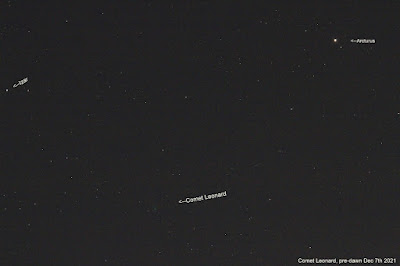Astronomy has caught my interest - and of course, after seeing Comet Neowise in 2020 [Link] --- I make an effort to witness and photograph most astronomy events.
If one does a youtube search for Comet Leonard - you can learn about where to look for it and when you can see it. It will be visible between this weekend and Mid-December.
This morning, I had set my alarm at 4am to check if it would be cloudless - and I was happy to see the star "arctures" from constellates Bootes over the eastern horizon. This comet was not at the brightness factor needed to make it a naked-eye visible comet. So, using my stelllarium android app, and "star-hopping" with my camera - I was finally able to find this fleeting comet. One of the coolest observations I made upon seeing this in my cameras image preview screen was that it had a greenish tinge to it.
Asrophotography notes: I set my camera to 3200 ISO and took several shots at +1-->+3 exposure, then repeated the process at ISO 6400. My Canon 7D is getting old - its 12 years old I think, and the shutter speed at the above settings was 2seconds to 8 seconds. With those longer exposures, you get a trailing effect with the starts from the rotation of the earth. Ideally, it would be nice to mount my camera on a star tracking device, which aligns with the north star, polaris, then rotates slowly to counter-act the rotation of the earth, allowing for long exposures without the trailing star effect. Many professional photos of this comet include star tracking long exposures, and stacked image processing which combines the data obtained from many photographs.
Ultra-Fast Comet!
"An amazing feature of this celestial visitor is that it’s an ultrafast comet. It’s traveling at 158,084 miles per hour (254,412 km/h or 70.67 km/second) relative to Earth." (earthsky.org)
https://earthsky.org/astronomy-essentials/comet-leonard-might-become-2021s-brightest-2022/
Time cycle for its Orbit
~80,000 years. We will probably not be alive in 80,000 years, so --- this is your only chance to see this one.















